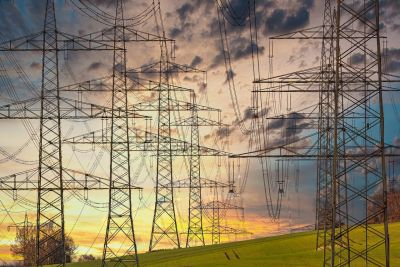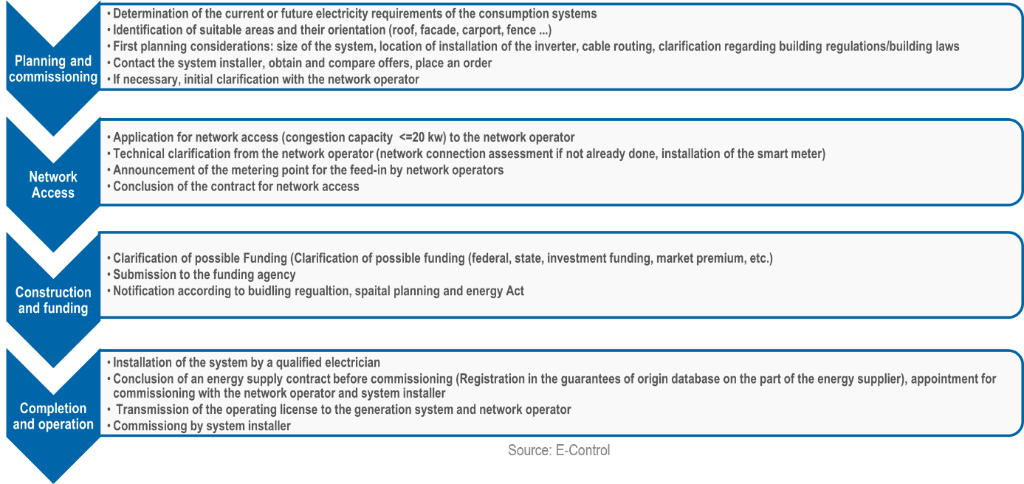
E-Control: Efficient grid connection of PV systems requires Photovoltaics as an important building block for achieving climate goals.
Electricity production from renewable energy sources needs to be increased by a total of 27 TWh by 2030. Photovoltaics should make a significant contribution to this by increasing it by 11 TWh by 2030. Photovoltaic (PV) systems on house roofs are playing an increasingly important role in this context.
According to E-Control board member Mr. Alfons Haber, it is not always easy to set up a PV system at home. In many cases, willing homeowners fail to find the appropriate network connections for their system. Inquires about network connections have also increased significantly at the E-Control Advice & Services Center in recent months. Therefore E-Control has developed its own grid connection action plan, which provides for a number of measures to speed up the implementation of grid connections. This is intended to ensure that network connections can be made significantly faster. Mr. Haber commented: “We are aware of the importance of the topic and must now take quick steps so that the expansion of renewables can move forward quickly.”
The Path to E-Control's Own PV System: “We know from our advice and services center that consumers would like to have a simple overview of how they can most efficiently get their own PV system. We complied with this request in two respects. We are currently producing one of our popular explanatory films on exactly this topic and the Action Plan is largely dedicated to PV systems. For example, there is also a separate chapter on the grid access process for PV systems” says Mr. Haber. He also explained that since there is always a lack of clarity regarding the terms, the Action Plan presents the terms clearly: “A network connection is the physical connection of a network user’s system to the network system. Network access includes the use of the network system.”
Many Systems are Already Online: Surveys carried out by E-Control among network operators show that there were almost 250,000 metering points for PV systems in Austria at the end of 2022. 97% of them were connected to the low voltage level. By 2030, renewable electricity generation in Austria is to be increased by 27 TWh. As mentioned, 11 TWh comes from PV, 10 TWh from wind, 5 TWh from hydropower, and 1 TWh from biomass. The aim here is to massively expand in all areas. E-Control assumes that around 100,000 new metering points are necessary per year for PV alone in order to achieve the renewable energy targets, which corresponds to an annual increase in installed PV capacity of 1 GW (1000 MW).
The Four Phases at a Glance: Broadly speaking, there are four essential steps that need to be followed in order to get your own PV system. These are planning and commissioning, network access, construction and funding, and finally completion and operation. (See the Graph below)

Graph: 4 steps to your own PV Panel
Summary of the Actions for more Efficient Grid
Connection for PV Systems up to 20kW
1. Applications for Network Access & Network Access via an Online Portal
Network customers should also be able to apply for network access themselves. There is the possibility throughout Austria that, in addition to authorized electrical companies, network users are also granted access to the network operator's online portal, as this is already possible with some network operators. This makes a grid connection assessment much easier and quicker.
2. Standardization of Processes for Grid Connection Assessment
Before setting up a PV system, the network operator must carry out a so-called network connection assessment and transmit it to the network user. Standardization of this process helps to ensure uniform processes throughout Austria to meet all deadlines. The time between receipt and confirmation of the application for network access should be a maximum of 14 days.
3. Simplifying Proof of Conformity
Grid operators can demand further evidence as part of the operating permit procedure for the PV system in the light of conformity of the system i.e. test reports to confirm compliance with the required technical properties. An existing and constantly updated inverter list creates facilitation and acceleration of the grid connection assessment, because the conformity of the inverter does not have to be checked in every individual case. In the future, the requirement to provide test reports will no longer apply to inverters if they are already included in the inverter list.
4. Transmission of the Metering Point Designations
Anyone who wants to set up a PV system needs its own metering point designation. The announcement of this by the network operator should take a maximum of 14 days. These legal requirements are based upon in Electricity Act 2010 and E-Control regulations (END-VO 2012). E-Control continues to closely monitor compliance with legal requirements on the part of distribution network operators.
5. Monitoring the Progress of Digitalization Measures
In order to continually improve the efficiency, reliability, and sustainability of the power grid further digitization measures are necessary. Among other things, smart meters must be installed to move forward more quickly with the appropriate communication technologies. E-Control will closely monitor the progress in the future.
6. Use of Alternatives if there is a Lack of Network Capacity
A huge problem for those who want to use PV is currently the feed-in restrictions for grid use. This means that sometimes the originally requested feed-in power is not granted at the requested grid connection point, but rather only a part of this, at least to the extent of the agreed extent of network use. An alternative grid connection point or a limitation of the feed-in power can be an option until the grid operator can ensure connection.
7. Publication of Network Development Plans for Distribution Networks
In the future, distribution network operators of a certain size will be obliged to table a network development plan every two years, in which the network investments planned for the next five to ten years are outlined. This will improve transparency about planned projects, the expected demand, and the planned procurement of flexibility services. In the future, these plans will be published uniformly, and E-Control will create a manual document in the near future.
8. Transparency of Network Capacities at Network Level 4 (Medium Voltage)
The distribution network operators are obliged to publish available network capacities per substation - network level 4 – on a quarterly basis. A clear presentation of this information is lacking for the time being.
9. Harmonization of Requirements for Emergency Power Systems
A PV system in combination with an electrical energy storage device can serve as an emergency power supply for your home in the event of a power outage. To do this, a safe disconnection from the power grid for island operation and then a safe restoration of the connection must be guaranteed. There is currently a lack of uniform guidelines for the relevant technical requirements. Harmonization will be necessary with regard to the technical requirements of the distribution network operators.
10. Clarification on Power Generation Systems with Different Owners
Individual distribution network operators currently are accumulating power from all PV systems at a common connection point, even if they are owned by different grid users. This can lead to a disadvantage for PV systems that are connected at a later date. PV systems from different owners are to be classified independently from each other when it comes to technical requirements.

